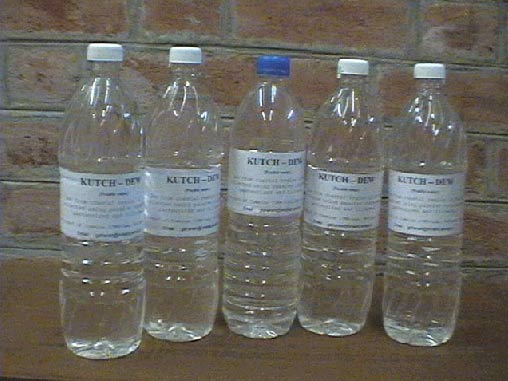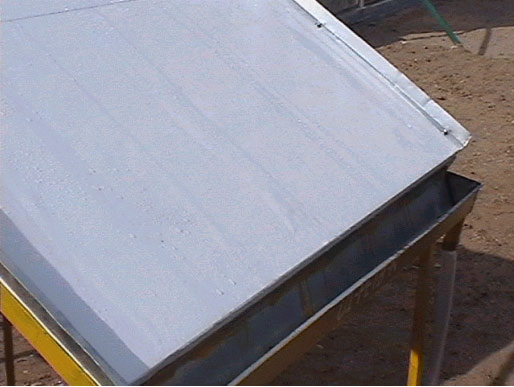| Plastindia Foundation has instituted "Plasticon
Awards" recognizing innovation & excellence
and these awards are presented to those who have
made path-breaking contribution for development
of Indian Plastics Industry. The Awards germinate
from a perceived need to honour and recognize excellence
of Organizations, Individuals, Companies and Institutions
actively involved in research and development of
plastics, and related products and honour their
path-breaking contribution to the overall development
of Indian Plastics industry. A write up on the Innovative
Product Award Winner - Indian Institute of Management,
Ahmedabad
Passive-dew-condenser is a device designed to
extract moisture from humid air without the use
of external energy. Under a clear sky at night
, the condenser surface gets cooled simply by
radiative exchange with sky, becoming colder than
the dew-point of the surrounding humid air. When
that happens some of the vapour contained in the
air condenses on its surface. The condenser surface
is set at an angle from the horizontal to permit
draining by gravity. When conditions are favorable
condensation could occur over good part of the
night yielding significant amount of water which
has been tested and found potable. Water only
needs to be filtered and sterilized by UV light
or boiling. Samples of dew water from a part of
Kutch are shown in Figure 1.

Figure 1: Dew water from Kothara - Kutch obtained
using passive dew
In the interior regions of India,
dew occurs only (or mostly) in winter months.
In coastal arid regions such as Kutch in Gujarat,
dew occurs over a period of 8 months from October
to May. In fact, measurements have shown that
dew occurs more frequently and in larger quantity
in summer months compared to others. It also happens
that good quality water is scarce in these regions.
Plastics has been successfully used to develop
dew harvest systems for people living in coastal
villages of Kutch to enable them to harvest dew
and use it as a supplementary source of water.
Suitably designed large cost-effective dew condensers
can enable humans too to extract moisture from
air. Plastics appear to be the most promising
material to achieve this. Besides the plastics,
metal sheets used for roofing can also be used
as condensers.
Development of condensers
The development work was spread over a three
year period and has passed through three stages.
In the first stage systematic measurement of daily
dew fall was made at Kothara, Kutch over a one
year period. In the second stage test condensers
were made and tried for one year. In the third
stage pilot scale condensers were made and tried.
Test
Test condensers were made using several materials
including polyethylene (PE) film, polyethylene
mixed with titanium-oxide and barium-sulfate (PETB)
film, fiber reinforced plastic (FRP) sheet and
poly-carbonate sheet. The PETB film was first
developed and tried for dew condensation in France
by Nilsson, Beysens and others. The film was made
to specifications. Galvanized iron and aluminum
sheets were also included in the trials.

Condensers made of plastic
A condenser has three components: a panel, mounting
frame and collection accessories. The panel is
made of two sheets bonded together with adhesive.
The sheet on top is made of material being tested
for its suitability to construct condensers, indicated
above. This sheet is insulated with styrene foam
sheet of 25mm thickness on the underside. Panels
are squares of 1x1 m. Panel is mounted on metal
frame made of welded angles. The collection accessories
(channel and tube) are also supported on the frame.
The panel is mounted with a 30 angle with the
horizontal. Flow is channeled via a flexible rubber
tube into a plastic bottle securely placed on
the ground.
All the test condensers were installed
in a coastal village - Kothara, Kutch - and daily
dew condensation was measured for one whole year.
Figure 3 shows the test site at Kothara.

Measurements showed that PETB
film gave the highest yield {Table 1(a)}
:
Monthly dew yield from north oriented Test condensers
(Kothara-04-05)
| Month |
GI |
Aluminium |
PETB |
| |
(ml) |
(ml) |
(ml) |
| Oct |
1060 |
1145 |
2620 |
| Nov |
320 |
260 |
830 |
| Dec |
370 |
245 |
345 |
| Jan |
195 |
140 |
135 |
| Feb |
2255 |
1530 |
2085 |
| Mar |
5285 |
2950 |
4920 |
| April |
2405 |
1090 |
3052 |
| May |
1498 |
435 |
2055 |
| Total |
13388 |
7795 |
16042 |
Table 1(b) : Dew nights from
north oriented condensers (Kothara-04-05)
| Month |
GI |
Aluminium |
PETB |
| |
(No.) |
(No.) |
(No.) |
| Oct |
9 |
8 |
12 |
| Nov |
4 |
3 |
5 |
| Dec |
3 |
2 |
3 |
| Jan |
2 |
1 |
2 |
| Feb |
12 |
11 |
12 |
| Mar |
28 |
20 |
26 |
| April |
18 |
8 |
12 |
| May |
16 |
5 |
12 |
| Total |
92 |
58 |
94 |
Trials in Kutch confirm the findings of Nilsson
and Beysens from France. Metal sheets give lower
yields specially the new commercial aluminium
sheets. FRP and polycarbonate also give good yields
but being expensive these are not suited for suited
for large practical harvest systems. 
Pilot
After analysis of the year-long measurements,
PETB was selected to make larger pilot condensers
for further trial. Figure 4 shows the pilot PETB
condenser. It consists of two basic modules, each
of 9m2 surface area or 3x3
m in size. The condenser surface is made of PETB
sheet of 400 micron thickness. Condenser is insulated
in the same manner as were the smaller ones. The
condenser modules are placed on a sand bed that
has a slope of 30o from the horizontal.
Commercial
Two types of models are ready for commercialization.
The smaller model is for individual families living
in coastal arid areas. It is called Dew Family-20.
The larger model is for communities and for commercial
bottling plants. It is called Dew Community-X.
Dew Family - 20 is sized for an average output
of about 20 liters per day during the season.
It will be built using 300 m2 plastic
(PETB) film. Total collection of dew water over
the season of 8 months would be approximately
5000 liters. The system will also harvest rain.
The systems could be installed at or near the
user's home (Figure 5).
Dew-Community systems will be larger and will
serve a community by bottling dew and selling
at affordable price locally. These will be built
on 'waste-land' and other locations along the
coast.
Dew harvesting be an attractive option in areas
where (a) dewfall occurs frequently, in appreciable
quantity over a long season and (b) where there
is shortage of potable water.

Figure 5(a) Roof over roof
dew harvest system On a tiled roof house - Front
view

Figure 5 (b) Roof over roof dew harvest system
On a tiled roof house - side view
|